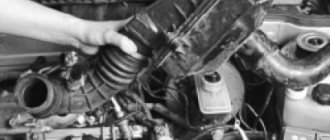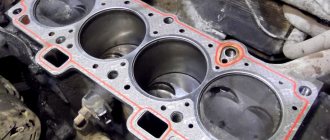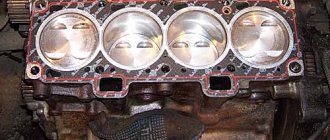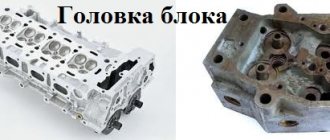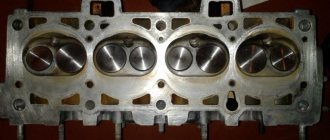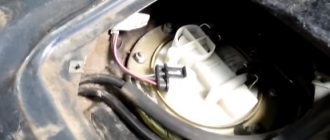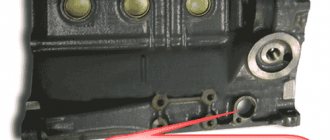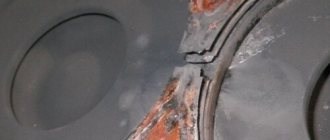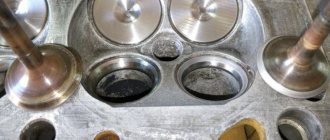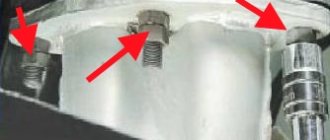The importance of the cylinder head in a car system cannot be overestimated. The dynamic performance of the vehicle largely depends on the condition of the structural elements of the unit. The head itself is attached to the block using fastening bolts, and so tightly that after disassembling the cylinder head, the fastening elements become unsuitable for further use. A special gasket ensures the tightness of the connection, preventing oil and coolant from leaking out. It has its own service life, so every driver sooner or later has to face such a task as replacing the cylinder head gasket.
Why does the cylinder head gasket wear out and how to check its condition?
Without exaggeration, the seal can be called the most important element of the cylinder head. There is no need to save money on replacing the gasket, because such attempts will ultimately result in serious engine damage. It is important to understand that this is a disposable material that requires replacement after any manipulation of the cylinder head. The following types of gaskets are known today:
- Non-asbestos – they are characterized by low collapse and high reproducibility
- Asbestos - reliable, plastic, able to withstand the high temperatures that prevail in the car system
- Metal ones are the most expensive type, but this makes them the most reliable. Many experts recommend installing them instead of conventional
It is almost impossible to visually assess the condition of the cylinder head gasket. To assess the ability of its further functioning, the factory and current fuel consumption for every 100 km are compared, and engine operation is diagnosed. Short trips in a car with a worn gasket can lead to serious consequences: the engine of a car with low mileage, but with an unsuitable cylinder head seal, in advanced cases, can only be revived through major repairs.
We note the following reasons for premature wear of the seal:
- Incorrect installation of elements during cylinder head assembly
- Prolonged overheating of the motor
- Operating a vehicle using low quality fuel
Engine overheating is the most common cause of gasket failure. An increase in the operating temperature of the power unit is observed during cooling system malfunctions and detonations. Even asbestos material cannot withstand critical temperatures, losing its strength, elasticity and many other important characteristics over time. The loss of its functional properties leads to blowing and complete destruction of the material.
Choosing a new gasket
It cannot be guaranteed that even with careful and correct maintenance you will completely eliminate the possibility of gasket failure. Therefore, every motorist is required to have a spare part with him.
Choosing a product is not so difficult. If you have a foreign car, then feel free to start from the car’s VIN code. The easiest way to find a part is this way, if you use the services of modern online services. Or take an alternative route, often used for domestic cars. For selection, you only need to know the make, model of the car and the installed power unit, which is also numbered and has its own corresponding designations.
The list of manufacturers is huge. But it is better to trust proven and well-established companies.
It is important to pay attention to the material used to make the head gasket.
This is interesting: Which shock absorbers are better to choose: gas, oil or gas-oil (pros and cons of struts, rating of companies)
There are 3 types of products:
- Non-asbestos. This gasket is characterized by fairly low shrinkage rates and excellent recoverability;
- Asbestos. The characteristics are similar to the first type of gasket. At the same time, the asbestos part is more resilient, heat-resistant and elastic. Often included in repair kits;
- Metal. The most effective, high quality and expensive. Allows you to evenly distribute surface pressure over the entire plane of the block and head.
Now decide for yourself. But it’s optimal to choose between the second and third options.
In what cases does the cylinder head gasket require replacement?
It is not possible to accurately determine when the cylinder head gasket will exhaust its service life. The functioning of the seal depends on the general condition of the structural elements of the power unit, driving style and other external factors. Every driver, even the most novice, can with a high degree of probability determine the complete wear of the cylinder head gasket by the following signs:
- At the junction of the block with the head, engine oil and coolant leak
- Changes in the nature of exhaust gases during engine warm-up
- Engine smoking
- The appearance of an emulsion in the coolant reservoir
If such symptoms of a breakdown are observed, it is recommended to replace the cylinder head gasket as soon as possible. In addition, the same manipulation must be carried out every time after disassembling/assembling the cylinder head. If a breakthrough of exhaust gases is clearly observed at the junction of the assembly elements, most likely the seal has been broken. It is for this reason that the engine will run much noisier.
It is much more difficult to recognize the wear of the cylinder head gasket if a defect appears on its surface located between the cylinders. The trouble is that the symptoms of the problem will not make themselves felt from the outside. The driver will be able to determine the cause of the malfunction only by indirect signs: increased fuel consumption, engine breakdowns and decreased vehicle power
If the seal between the combustion chambers burns out, the air mixture will mix with the exhaust gases. In this case, the driver will observe unstable engine operation when cold, but after warming up the problem, as a rule, temporarily disappears. The only and most effective way to determine the cause of unstable operation of the power unit is to measure the compression level.
What it is
The gasket is used to seal the contact point between the cylinder head and the block itself. Some people don't know the difference between valve cover and cylinder head gaskets. These are different parts, although they are located nearby.
What is a cylinder head gasket
The peculiarity of the seal is that it is capable of performing three important functions at once - sealing the gas distribution and oil systems, as well as the car’s engine cooling system. Therefore, the gasket must be strong enough and there are such high requirements for it.
Cylinder head gasket
Note! The cylinder head gasket must be changed for all types of engine repairs, since it is a one-time use item.
Replacing the cylinder head gasket: we do the work ourselves
It’s worth starting with the fact that the process of dismantling the cylinder head on some vehicles is a labor-intensive task. It is first necessary to drain the technical fluids and dismantle the auxiliary components and assemblies of the vehicle. All this requires a lot of time and effort. Before you start replacing the gasket, it is important to make sure that the assembly is level on the cylinder block. The work surface should be thoroughly cleaned from dirt, dust and all kinds of defects. The process of replacing the cylinder head gasket yourself comes down to the following steps:
- Initially, the battery is removed from the car
- All hoses and pipelines are dismantled, simultaneously marking them with a marker for subsequent easy connection
- Fuel lines are removed
- Attachments that prevent the cylinder head from being freely removed are dismantled.
When the paths to the cylinder head approach are completely cleared, the unit itself can be dismantled. After which it is important to remove the cover and timing belt; professional auto mechanics also recommend diagnosing the dismantled parts and assemblies. It would not be superfluous to visually inspect the camshaft oil seal. Installation of the cylinder head gasket is only possible on a pre-cleaned seat. The material must lie on all guide bushings and fit the center grooves.
If a stud breaks, you can use a simple but effective method: weld a tube of smaller diameter than the fastener itself to the broken part. After scalding from the inside, it will not be superfluous to weld the nut, which will only facilitate the quick and easy removal of the broken part of the bolt
The sequence of tightening the mounting bolts and the force applied is extremely important. To do this, it is best to arm yourself with a special scheme, which will not be difficult to obtain on the Internet. It provides all the information useful to the driver from the engine manufacturer. Further work comes down to installing in reverse order all dismantled auxiliary equipment, hoses and lines.
How to check the gasket for defects?
Before starting repair work to replace the cylinder head gasket, we recommend checking it for damage using the following methods:
- Magnetic powder diagnostics is considered the fastest and easiest method. Install magnets on all sides of the cylinder head and sprinkle the cylinder head with metal shavings. It will move to the magnets, but will remain in the defect zone.
- Pressure testing without immersion in water involves using a soap solution. It must be poured onto the plane of the cylinder head cover and compressed air supplied to the circuit. The appearance of bubbles indicates microcracks.
- Applying immersion pressure involves completely submerging the head in a container of hot water. Next, compressed air is supplied using the same principle, and bubbles will indicate defects.
- Water can also be tested without immersion. Close the holes tightly and pour water into the channel. Pump air to ensure a minimum pressure of 0.7 MPa. After 2 - 3 hours, check for water. If it is not there, the gasket is defective.
After replacing the cylinder head gasket, how important is broaching?
After replacing the seal, the driver’s first priority is to monitor the operation of the power unit. The engine must operate stably and without interruptions, and its temperature must not exceed permissible levels. It is advisable to carry out cylinder head pulling 20-30 km after replacing the asbestos material. The head is pulled much earlier if, after the work has been carried out, there is leakage of engine oil at the junction of the unit with the cylinder block during vehicle operation. For these purposes, they are armed with a torque wrench and do all the tightening work with the force recommended by the motor manufacturer.
Replacing a cylinder head gasket is not an easy job for a novice driver, but if you arm yourself with the appropriate equipment and enough free time, anyone can do the whole job on their own. Pay attention to the quality of the new cylinder head gasket, because the further trouble-free operation of the car depends on its properties. Even if there is no need to replace it, but it is planned to remove the cylinder head for any work, for preventive purposes, replace the seal with an original copy or an analogue from a reputable manufacturer.
Diagnostic features
Everything mentioned above is circumstantial evidence. But to confirm the diagnosis, detailed diagnostics are required. Below are sequential instructions.
- Start the engine and inspect it for smoke leaks. Particular attention should be paid to the gaps between the block and the cylinder head.
- Inspect the oil filler neck. If the seal breaks, reddish traces of the emulsion will be visible on the neck.
- Check to see if white smoke is coming from the muffler. The presence of white smoke from the exhaust system is usually indicated by a burned-out cylinder head gasket. The smoke is most often sweet.
- Place a balloon on the neck of the radiator. If the ball inflates while the engine is running, this indicates bubbling of the antifreeze and, accordingly, a violation of the integrity of the seal.
- Check engine compression. If the level is below normal, then the gasket probably needs to be changed.
Condom for checking cylinder head gasket
After diagnostics, you can easily determine whether the cuff needs to be replaced. Then everything is done according to the instructions.
Types of structures
- Berasbestos - made of composite materials, characterized by low shrinkage and the ability of the material itself to recover.
- Asbestos and thale-asbestos are similar in their properties to non-asbestos, the same elasticity, heat resistance, elasticity. Currently used in most automobile engines. They are based on a fibrous fire-resistant material, asbestos, prepared in the form of a thin sheet. To give strength, it is additionally reinforced with a metal mesh or perforated steel sheet, then a ready-made gasket is cut out from the resulting sandwich. The gasket must accurately follow all planes and channels of the cylinder head. Along the contour of the combustion chambers, oil channels and other thin bridges, asbestos gaskets are additionally edged with a thin layer of soft metal. This metal edging significantly increases mechanical strength and increases the density at the junction of the cylinders, which can significantly increase the service life and degree of boost of the engine. To reduce the adhesion properties of the gasket, its surfaces are additionally treated with graphite lubricant.
- All-metal gaskets are made from thin sheets of soft metals - aluminum, copper, mild steel. They are considered the most effective; with such a gasket, pressure and temperature are evenly distributed over the entire mating plane. Used on diesel engines of trucks, air-cooled engines, as an additional gasket to reduce compression.
